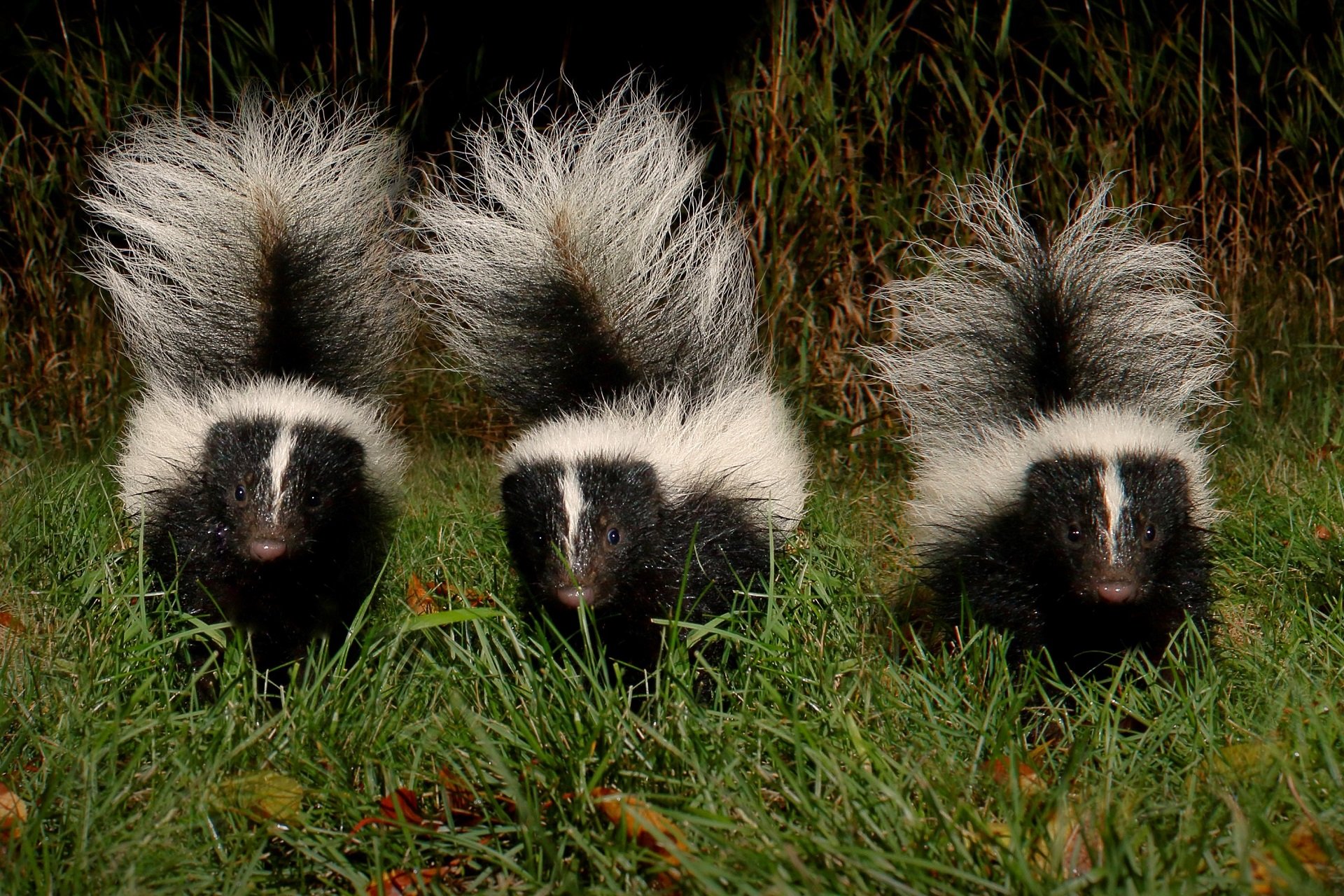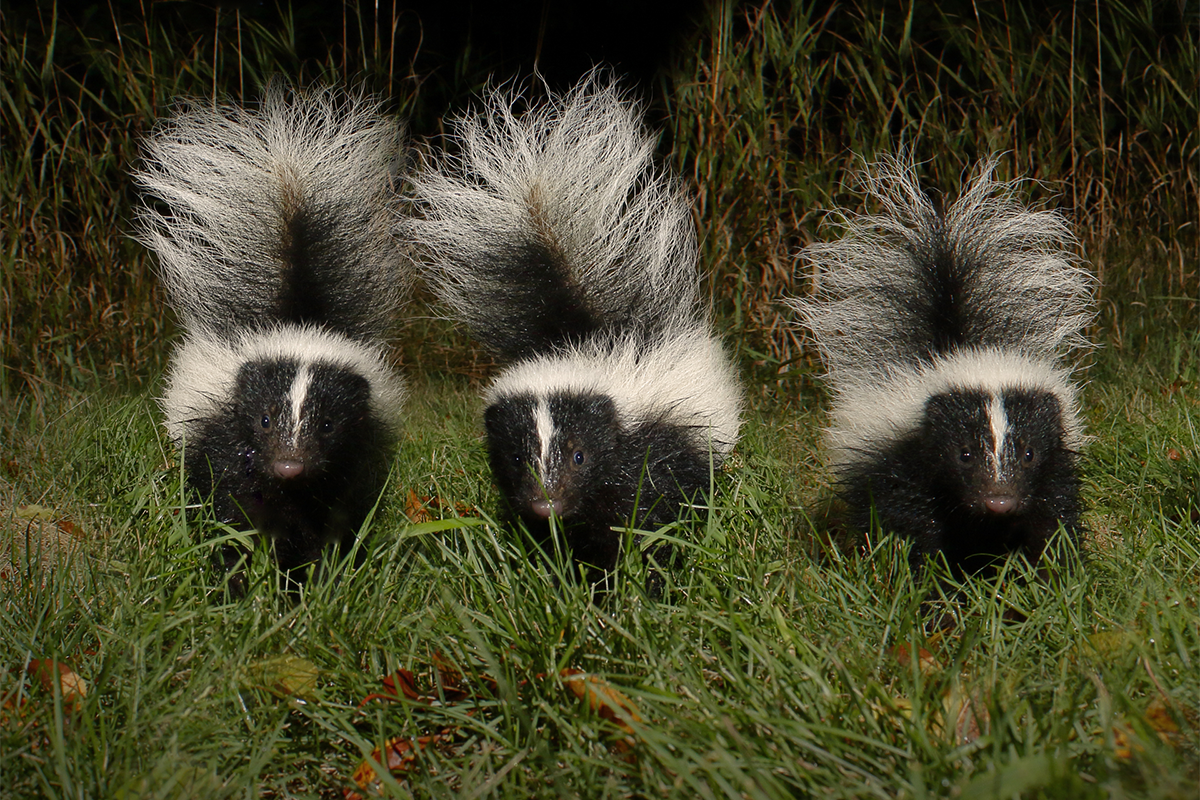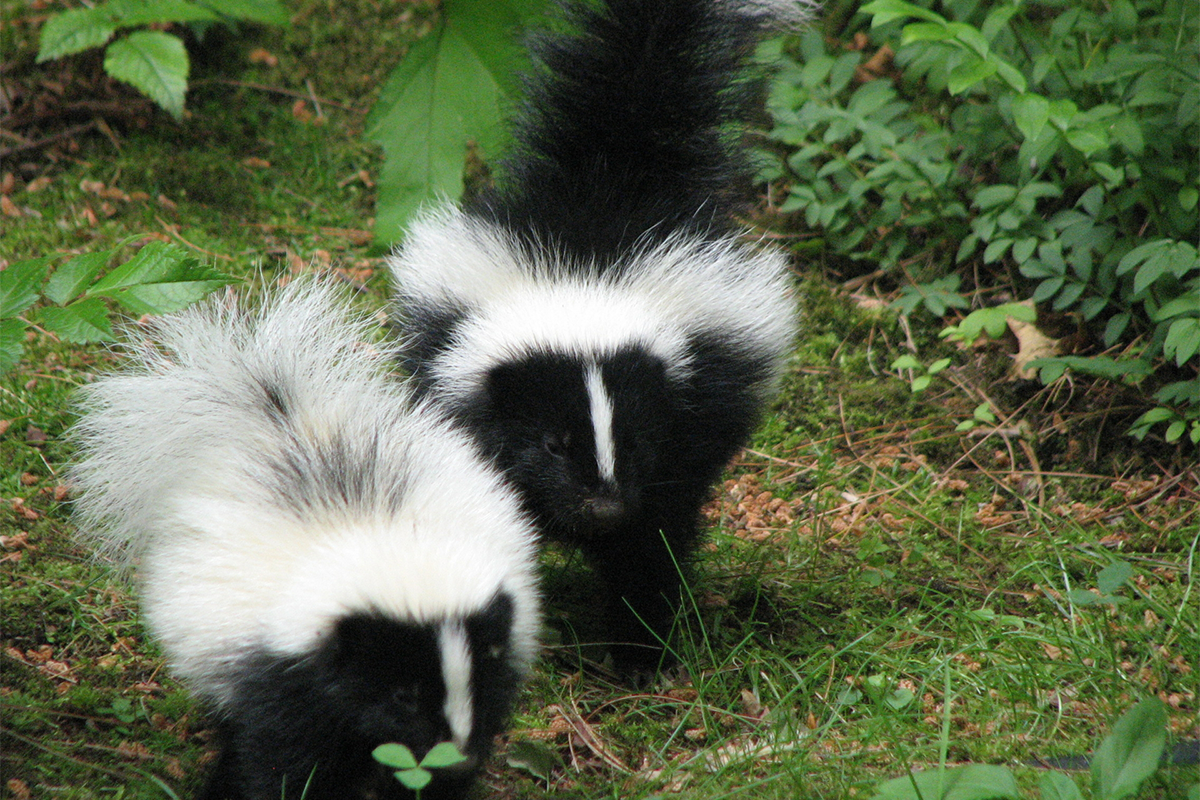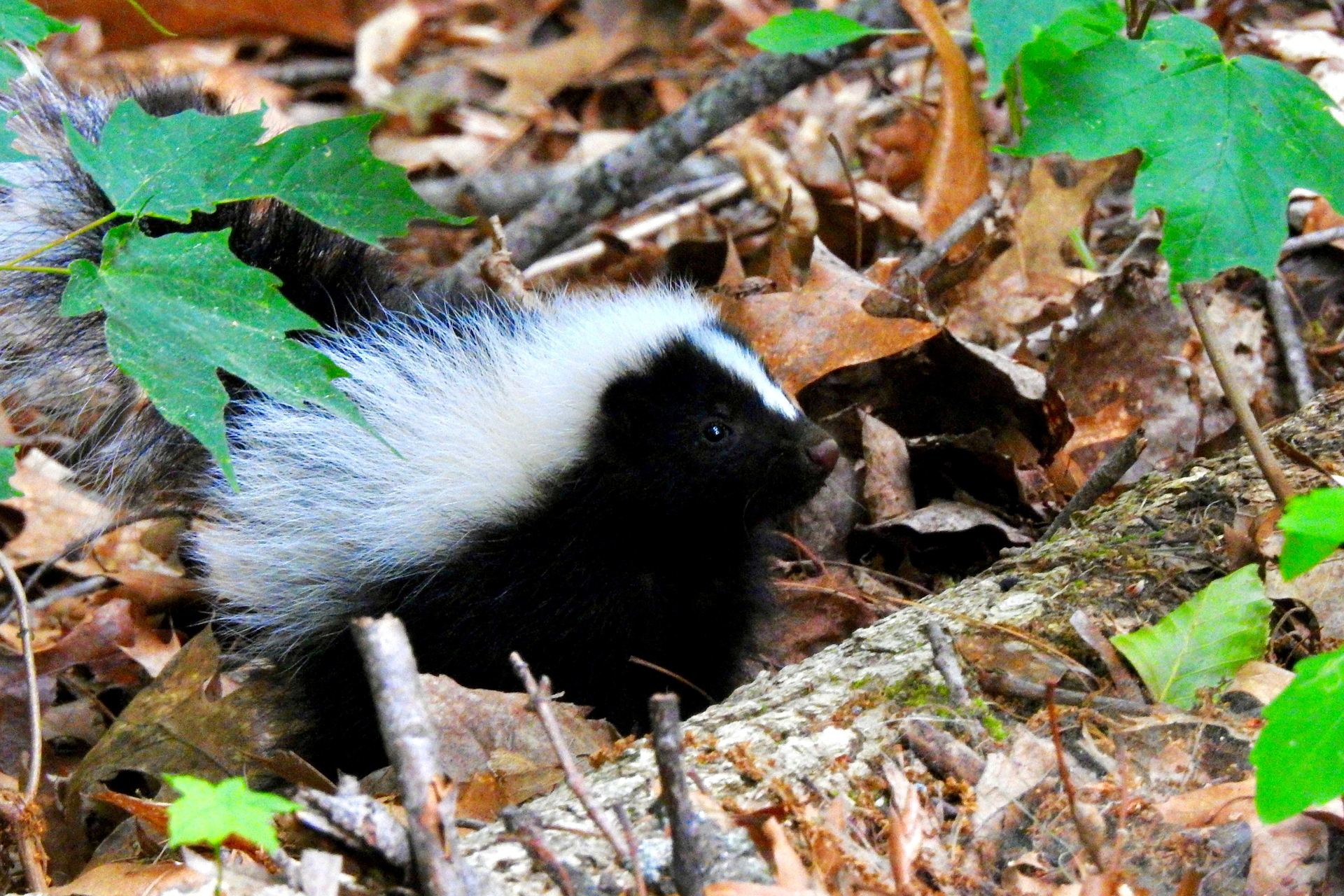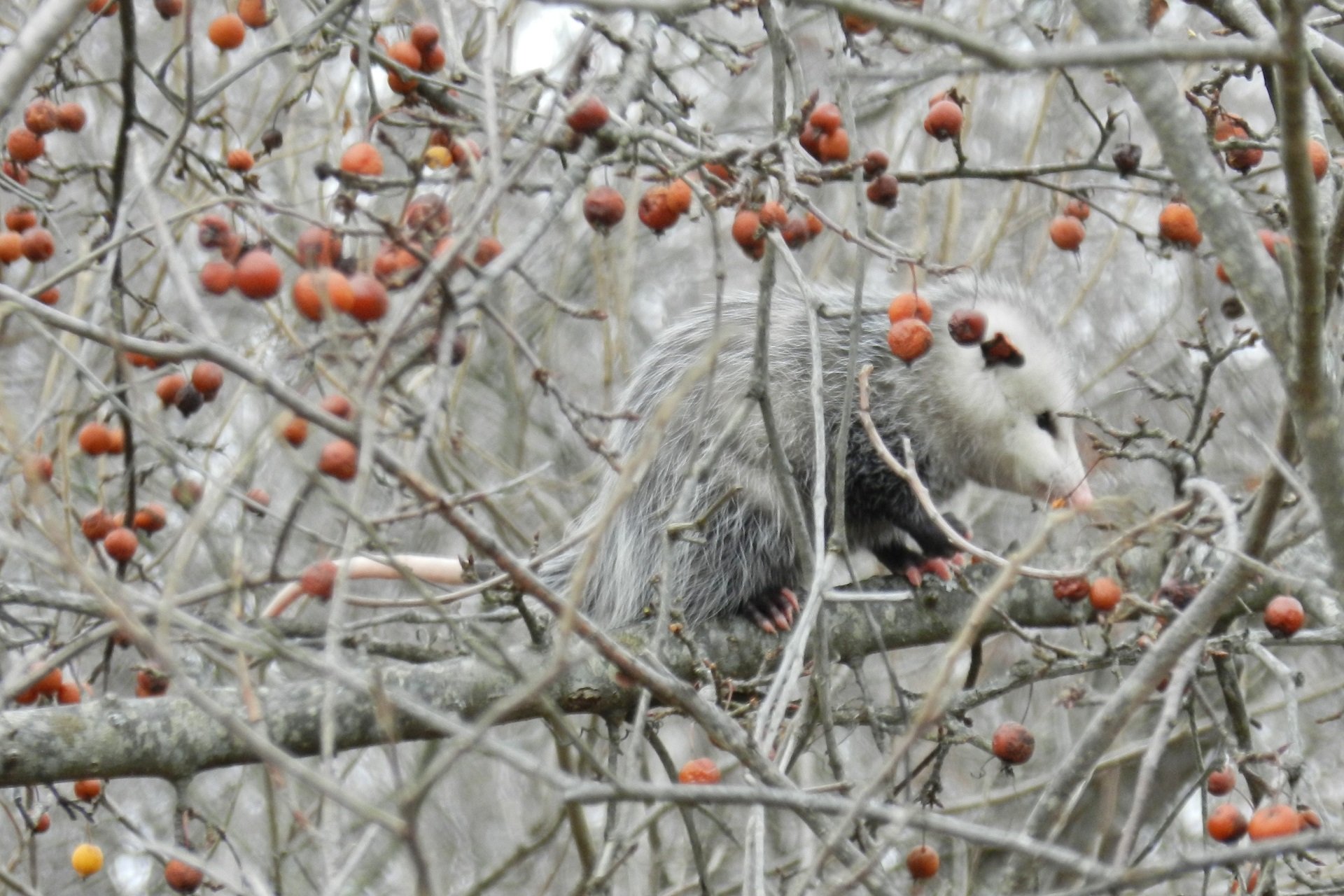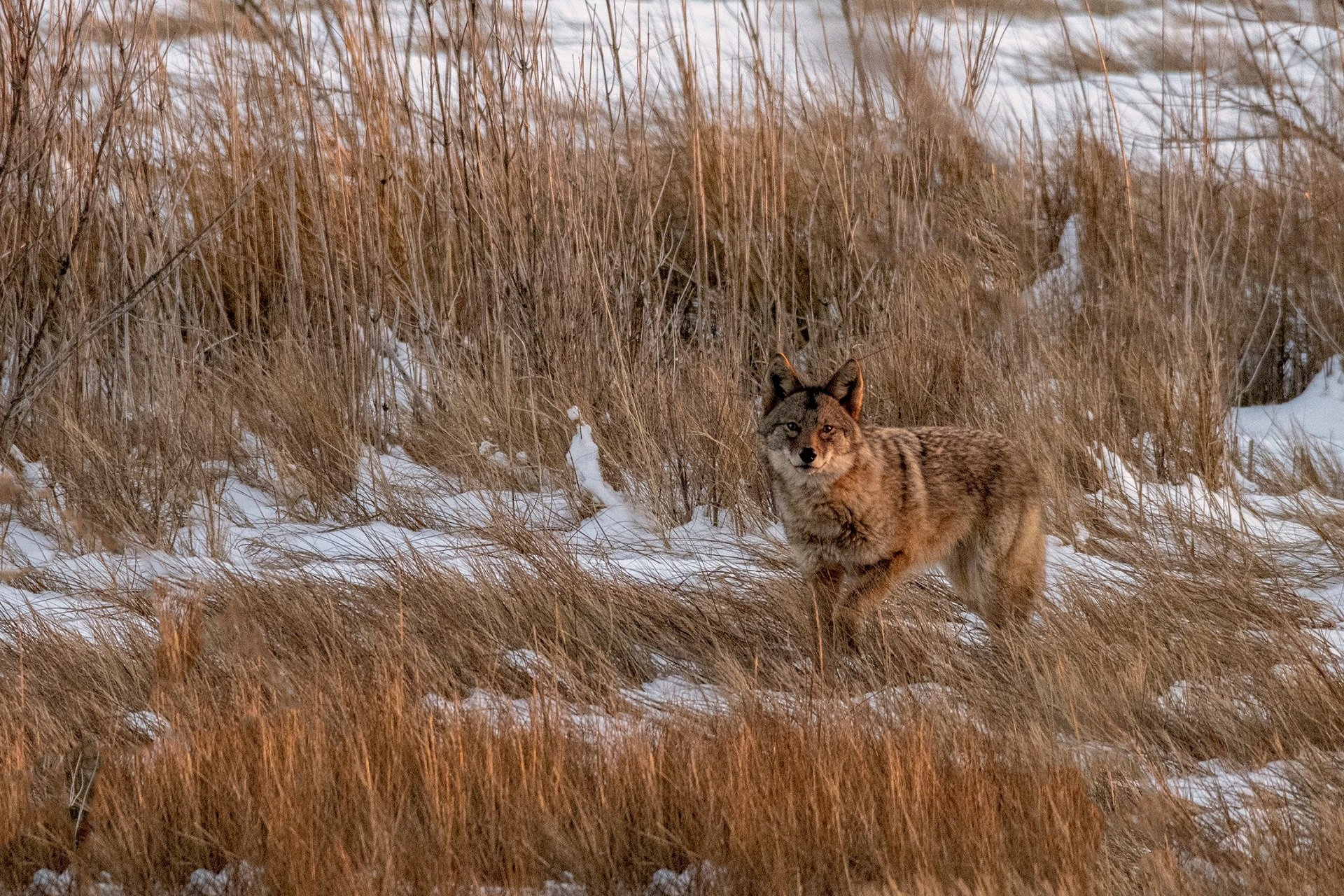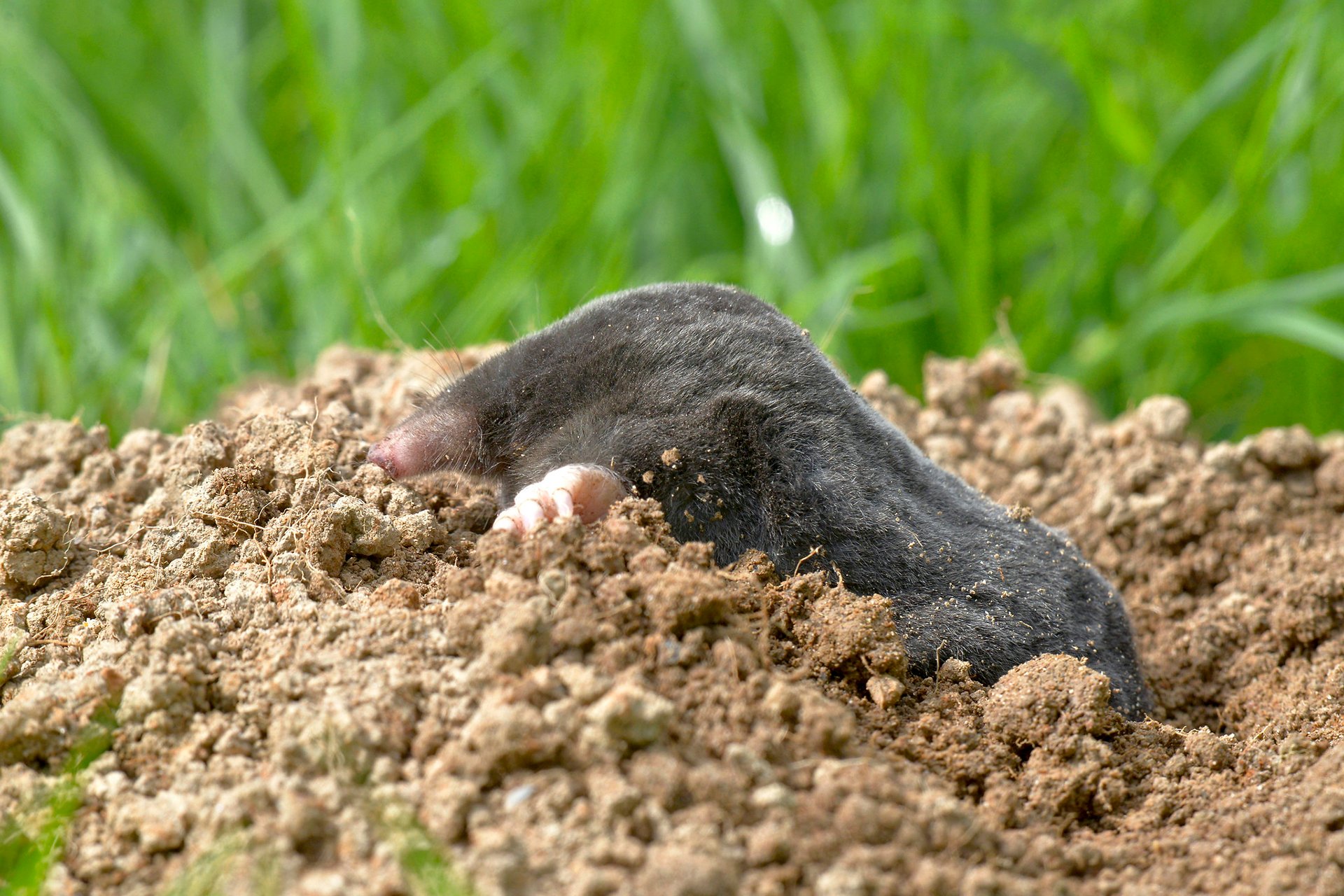Mammals in Massachusetts
Skunks
With their bold black and white patterning, bushy tails, wobbly gaits, and distinct odor, skunks are easy to recognize. Five species of skunks live in the United States, but only the Striped Skunk (Mephitis mephitis) can be found in Massachusetts.
How to Identify a Skunk
The distinctive white stripes seen along a skunk’s back are like fingerprints—unique to each skunk. The stripes point to their sprayer glands at the base of their tail, which they use as a defense mechanism when they feel trapped or threatened. You’ll often smell a skunk before you see them, an odor reminiscent of sulfur, garlic, and burnt rubber.
Coloration varies among individuals—brown, all black, and albino skunks sometimes occur. Males and females look alike, though the females can be smaller. An adult skunk is the size of a domestic cat, about 29 to 36 inches long, including their very bushy tail. They have short legs, which aren’t great for climbing, but their long nails are great for digging.
Skunk Behavior
Are Skunks Nocturnal?
Skunks are normally nocturnal. They spend the day sleeping in burrows or under porches and exit in the evening to search for food.
Do Skunks Hibernate?
While they do not hibernate, skunks can enter a state of torpor, a sort of deep sleep from which they awake from time to time. Torpor is influenced by the temperature and food availability. When a skunk goes into torpor, their body temperature can drop 20 degrees and their metabolism slows. Skunks settle into their den typically from November–March with sometimes three or four adults sleeping together during severe weather. They will emerge on warm winter nights when the temperature is above 30°F.
What Do Skunks Eat?
Skunks usually keep their foraging range just under a mile, though males and young animals sometimes wander as far as five miles. As omnivores, small rodents, insects, and seasonal fruits to make up most of their diet. Immune to snake venom, they can even eat poisonous snakes like rattlesnakes.
They also eat the eggs of young ground-nesting birds and regularly dig up turtle eggs. Sometimes they will claw through the nests of yellow-jacket wasps. They seem to favor the grubs of Japanese beetles and June beetles, which feed on the roots of lawn grasses. Skunks also love garbage and any pet food set outside, so be sure to keep trash secured.
Where Do Skunks Live?
The Striped Skunk occupies a variety of habitats, including fields, woodlands, and suburban and urban locations where they are at home under porches, decks, and sheds. They may excavate a burrow, which can reach 3-4 feet below ground and 6-20 feet long, ending in round chambers lined with leaves and grass. More often a skunk will take over the burrows of woodchucks or foxes.
Skunk Life Cycle
2-10 kits are born between late April and early June after a gestation period of 62-68 days. The young are born helpless, blind, and hairless, although the striped pattern is already distinguishable on their bodies. Their eyes open at about 22 days and at 6-8 weeks they begin to forage for food with their mother. Skunks only live for 2-3 years in the wild but can live up to 15 years in captivity.
What To Know About Skunk Spray
If given the opportunity, skunks would prefer to walk away from danger and spray only as a last resort. Two glands located on either side of the anal opening eject a yellowish, oily substance (an organic compound called a thiol) that contains the active ingredient in skunk musk, n-butyl mercaptan. Skunks can project the fluid, emitted as a fine spray or stream, at a distance of 15 feet and have sufficient supply for five consecutive discharges.
Should you and a skunk meet, stand still or slowly back away so the skunk doesn’t feel trapped. Skunks will give a warning that they are about to spray by arching their back, raising their tail high in the air, turning backwards to the enemy, and stomping their front feet.
What to Do If You or Your Pet is Sprayed by a Skunk
To prevent you or your pet from being sprayed, check the yard before going outside at night. If you do come across a skunk, give them plenty of space and avoid interaction.
If the spray gets in you or your pet’s eyes, flush with water for 10 minutes to relieve the discomfort. The spray won’t cause permanent damage, but it can sting. Avoid rubbing your eyes.
If you find spray on your body or your pet’s coat, wipe it with a paper towel first. Then mix 1 quart of hydrogen peroxide (3%), ¼ cup of baking soda, and 1 teaspoon of dish detergent in a bucket. Use an old washcloth to apply the solution to the skin, hair, or fur of the person or pet, avoiding the eyes, ears, and mouth.
If needed, re-apply the solution and rinse again. Use this mixture immediately; do not store. Hydrogen peroxide does bleach, so if you’re concerned about lightening hair or fur, substitute white vinegar.
To clean outdoor furniture that’s been sprayed by a skunk, wash with a solution of 1 part bleach and 9 parts water. Don’t use this mixture on fabric.
Should a skunk spray indoors, vent the building as much as possible by placing fans in open windows or doors to draw the odorous air out. Place boxes of baking soda around the area and be patient; the odor will dissipate with time.
How to Deter Skunks
For a skunk living under a porch, deck, or other building, seal all openings except one. During the day, while the skunk sleeps inside, loosely stuff the remaining opening with leaves or dirt. When the leaves have been pushed away from the opening you will know that the skunk has left and that you can now close the opening.
You can discourage a skunk from returning by placing a bright light under the structure after the skunk has left for the night. However, this offers only a temporary solution.
Please note: Do not attempt to remove the skunk between May and July, as the den is likely to have young in it. The young are not old enough to leave with the mother and you will trap them inside. The mother can cause damage to your home to free her offspring, and should the young die, you will have a serious odor and insect problem.
Skunks in Garages
Occasionally a skunk will walk into a garage or other building through an open door. Leave it alone and it will depart on its own, probably at night. If you want to be sure a skunk has left, spread flour in front of the door, then at night, place a half can of fish-flavored cat food or sardines outside, about 20 feet away from the entrance. Check the flour for footprints to be sure the skunk has left and close the opening.
Skunk Stranded in a Window Well
Skunks frequently fall into basement window wells and become trapped. To free the animal, place a long, rough (for traction) board into the window well for the skunk to use as a ramp. Lower the board slowly into the well and provide the gentlest slope possible and the skunk will climb out at night.
Skunks & Lawns
When seeking grubs of June beetles and Japanese beetles, skunks often roll back small areas of turf. Though aesthetically annoying, these temporary disfigurements benefit your lawn in the long run. An infestation of grubs will cause the grass to die and turn brown, so having skunks as predators can keep them in check.
If you want to discourage a skunk from digging up the lawn, purchase a large sheet of fruit tree netting (also called bird netting), which you can find at garden centers. Lay the netting on the ground over the damaged area. Bunch, or gather (as you would a curtain), the edges of the lining; the "hills and valleys" in the netting will discourage the skunk from walking through it.
Threats Facing Skunks
Skunks are an important part of a healthy, thriving ecosystems. Predators of skunks include coyotes, foxes, Great-horned Owls, and domestic dogs. They can also be injured or killed by vehicles. Like other mammals, skunks can be infected with rabies.
How Mass Audubon Supports Skunks
Mass Audubon works at our wildlife sanctuaries and beyond to ensure that the nature of Massachusetts continues to thrive. By scientifically monitoring Massachusetts wildlife, Mass Audubon informs important conservation decisions and launches targeted initiatives to help at-risk species. In addition, fostering healthy habitats, advocating for supportive policies, and educating people about the importance of nature conservation is critical to our success. Learn more about our work
How You Can Support Skunks
Mass Audubon supports wildlife like skunks every day, but we couldn’t do it without the support of our 160,000+ members.
Help us support skunks, and animals like them, by becoming a member today.
Stay Connected
Don't miss a beat on all the ways you can get outdoors, celebrate nature, and get involved.



